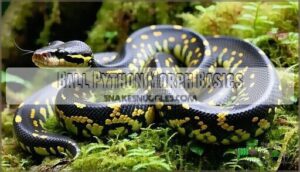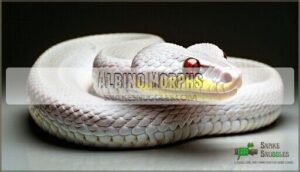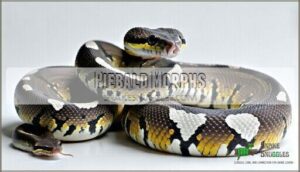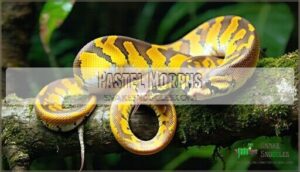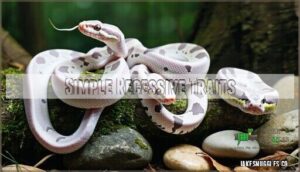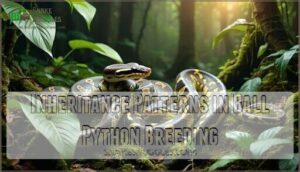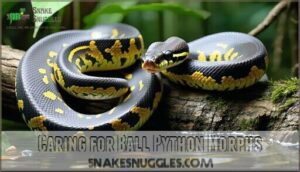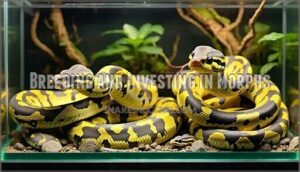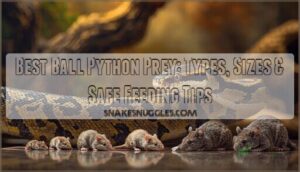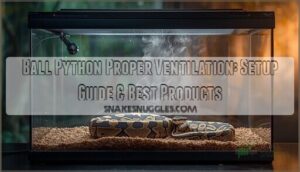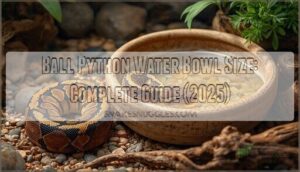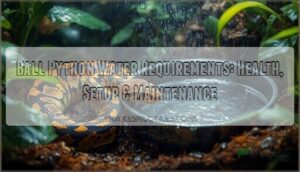This site is supported by our readers. We may earn a commission, at no cost to you, if you purchase through links.
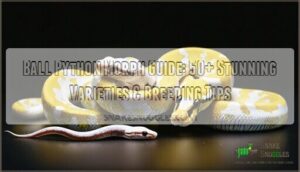
These morphs result from selective breeding of naturally occurring mutations, producing everything from pure white leucistic snakes to vibrant yellow pastels and intricate piebald patterns.
Each morph follows specific inheritance patterns—some are recessive (requiring two copies), others dominant (needing just one), and co-dominant traits blend together.
Popular morphs include albino, spider, pastel, and axanthic varieties.
While most morphs don’t require special care beyond standard ball python husbandry, some genetic combinations can affect neurological function or visual abilities.
The morph market ranges from affordable $100 pastels to rare combinations worth thousands.
Understanding basic genetics helps predict breeding outcomes and spot potentially problematic gene combinations that experienced breeders navigate carefully.
Table Of Contents
- Key Takeaways
- Ball Python Morph Basics
- Types of Ball Python Morphs
- Genetics of Ball Python Morphs
- Caring for Ball Python Morphs
- Breeding and Investing in Morphs
- Frequently Asked Questions (FAQs)
- How many ball python morphs are there?
- How do you identify a ball python morph?
- How do ball pythons morph?
- What is the difference between a ball python and a morph?
- What is the most sought after ball python morph?
- Which ball python morphs are dominant?
- What do different ball python morphs mean?
- What ball python morphs look normal?
- How much do specific ball python morphs cost?
- Are certain morphs more prone to health issues?
- Conclusion
Key Takeaways
- You’ll need to understand basic genetics – Ball python morphs follow specific inheritance patterns (recessive, dominant, co-dominant) that determine which traits appear in offspring, so learning these patterns helps you predict breeding outcomes and avoid problematic gene combinations.
- Different morphs require specialized care – While most share standard husbandry needs, certain morphs, like spiders, have neurological issues, albinos need reduced lighting, and some have feeding difficulties that require adjusted care approaches.
- Morph pricing varies dramatically by rarity and genetics – You can find basic morphs, like pastels, for $50-100, while rare designer combinations with multiple recessive genes can cost $1,000-15,000+ depending on visual appeal and genetic complexity.
- Some morphs carry serious health risks – Spider complex morphs develop "wobble" syndrome, causing balance problems, while other combinations can affect fertility, immune function, or neurological development, making research essential before purchasing or breeding.
Ball Python Morph Basics
You’ll discover that ball python morphs are genetic variations that create stunning color and pattern combinations through inherited traits.
These fascinating snakes result from both natural mutations and careful selective breeding, producing over 4,000 recognized morphs that range from common varieties to rare designer combinations worth thousands of dollars, which are genetic variations.
Genetic Mutations in Ball Pythons
Genetic mutations in ball pythons create stunning visual diversity through altered DNA sequences affecting pigment production.
Over 400 ball python morphs exist, with mutations impacting melanin genes like TYR, OCA2, and TYRP1.
These genetic changes produce everything from albino’s red eyes to axanthic’s grayscale patterns.
Novel mutations continuously emerge through selective breeding, creating unique trait interactions that fascinate collectors worldwide.
Natural Vs. Selectively Bred Morphs
Understanding the difference between natural and selectively bred ball python morphs helps you appreciate genetic diversity.
Wild type pythons from West and Central Africa occasionally display natural mutations like albino or piebald, occurring in fewer than one in 5,000 specimens.
Selective breeding amplifies these rare traits, creating over 400 captive morphs with vibrant colors never seen in nature, raising ethical concerns about conservation impact.
Impact on Appearance and Coloration
Ball python morphs dramatically transform your snake’s appearance through Pattern Alterations, Color Intensification, and Scale Variations.
You’ll notice striking differences in Eye Color and Unique Markings compared to wild-type pythons.
These ball python morphs create stunning visual displays—from vibrant yellows in banana morphs to deep blacks in axanthics.
Each python morph guide reveals how snake morphs and reptile morphs showcase ball python genetics through remarkable aesthetic changes.
Morph Popularity Among Breeders and Collectors
Collectors chase rare morphs like trophies, driving demand through rarity influence and morph aesthetics.
Looking at the paragraph you’ve highlighted, here’s a short, engaging blockquote in the same tone:
**Rare morphs become collector’s gold, commanding prices that reflect their genetic artistry.
Designer combinations command premium prices, creating substantial investment potential in the reptile morphs market.
However, ethical concerns arise when breeders prioritize profit over animal welfare.
Popular morphs shift with trends—what’s hot today might cool tomorrow.
Smart collectors focus on proven genetics rather than fleeting fads, using python morph guide resources for informed decisions about snake morphs and ball python genetics for successful morph identification.
Many breeders focus on selective breeding practices to create unique morphs.
Types of Ball Python Morphs
You’ll discover that ball python morphs fall into several distinct categories, each with unique genetic traits that create stunning visual variations.
These categories include albino morphs with their striking yellow and white patterns, piebald morphs featuring dramatic white patches, spider morphs known for their intricate web-like designs, pastel morphs that enhance natural colors, and axanthic morphs that eliminate yellow pigments for monochromatic beauty.
Albino Morphs
You’ll find albino python varieties stand out with their striking yellow and white coloration paired with distinctive red eyes.
These morphs result from a complete absence of melanin, creating stunning contrast patterns that make them highly sought after in the reptile community.
Key albino characteristics include:
- Heat sensitivity – Red eyes make them more sensitive to bright lighting and temperature changes
- Breeding albino pairs requires understanding recessive genetics for successful offspring prediction
- Albino price ranges from $300-$500, making them accessible entry-level designer morphs.
Popular albino variations include Caramel Albino, combining lavender and cream tones, and High Contrast Albino.
When building your morph list, these common morphs serve as excellent foundation genetics.
Proper morph identification focuses on the characteristic red eyes and absence of dark pigmentation, distinguishing true albinos from amelanistic varieties in python genetics.
Piebald Morphs
Piebald genetics create stunning pattern variations through recessive inheritance, requiring two copies of the gene for expression.
You’ll find high white piebalds with extensive white patches and low white specimens showing minimal white markings.
These recessive morphs offer exciting breeding combos when paired with other traits, producing offspring that showcase unpredictable white distributions across their bodies, making each piebald python unique in the morph list.
Spider Morphs
You’ll encounter spider pythons with striking patterns that unfortunately come with serious genetic disorders.
The spider complex produces beautiful morphs through spider genetics, but these snakes suffer from wobble – a neurological condition causing head tremors and disorientation.
While wobble issues vary in severity, ethical considerations make many breeders avoid spider morph combinations.
Some continue breeding despite these breeding concerns, hoping future research will address these genetic disorders affecting the spider python lineage, and ultimately find solutions to the problems caused by genetic disorders.
Pastel Morphs
Pastel morphs showcase brighter colors and enhanced patterns compared to normal ball pythons.
You’ll notice increased yellow, orange, and brown tones with sharper contrast between light and dark areas.
Pastel genetics follow co-dominant inheritance, meaning Super Pastel combinations produce even more intense coloration.
These pastel python variations serve as excellent foundation stock for designer morphs, with morph prices ranging from $50-150.
Their vibrant Pastel intensity makes them popular for creating stunning rare morphs through selective morph combinations.
Axanthic Morphs
Axanthic genetics create mesmerizing grayscale snakes that look like living photographs. These morphs lack yellow pigment, resulting in striking black, white, and silver patterns that captivate collectors worldwide.
- Appearance variations: Axanthic genetics produce stunning monochrome snakes with enhanced contrast between dark and light scales
- Breeding challenges: Axanthic combos require careful genetic planning since the trait is recessive and needs specific pairing strategies
- Pricing factors: Basic axanthic morphs start around $400, while complex axanthic combos can reach thousands depending on rarity
- Hereditary traits: Understanding axanthic genetics helps predict offspring outcomes when planning morph breeding projects for snake coloration goals
Genetics of Ball Python Morphs
Understanding ball python genetics isn’t as complex as it might seem, and you’ll find it fascinating once you grasp the basic inheritance patterns.
These genetic principles determine whether your favorite morph will appear in offspring and help you predict breeding outcomes with surprising accuracy.
Simple Recessive Traits
Understanding simple recessive traits forms the foundation for successful ball python breeding.
These genetic traits require two copies of the same recessive gene to create a visual morph in your snake’s appearance.
| Trait Type | Examples |
|---|---|
| Albino Complex | Albino, Amelanism variants |
| Reduced Pigment | Axanthic, Hypomelanism |
| Pattern Changes | Clown, Genetic Striped |
When breeding for recessive inheritance, you’ll need two het (heterozygous) parents or one visual paired with a het to produce visual offspring.
Double recessives create stunning combinations but present breeding challenges since you’re working with lower odds.
Visual identification becomes tricky with hets since they carry the gene invisibly.
This genetic diversity keeps the hobby exciting while requiring patience and strategic planning.
Dominant Traits
Dominant morphs show their visual effects when you’ve got just one copy of the gene, making them highly sought after for breeding programs.
Unlike recessive traits that hide, dominance expression means you’ll see the morph characteristics immediately in offspring.
These genetic traits create striking python variations that pass to roughly 50% of babies when breeding with normal ball pythons.
Super forms develop when both parents contribute the same dominant gene, often producing even more dramatic appearances with intensified colors and patterns.
Understanding heritability factors is key to predicting these outcomes.
Co-dominant and Incomplete Dominant Traits
These genetic wildcards create fascinating breeding puzzles where you’ll see one copy of a gene producing a milder version of the trait compared to two copies.
Co-dominant expression means both genes show up visually, creating unique trait combinations. Unlike simple recessives, these python variations display visual variations even when heterozygous.
Understanding how mutation rates create variations is key to producing novel morphs.
When breeding, you can predict specific breeding outcomes based on parent morph characteristics, making snake genetics particularly exciting for reptile breeding enthusiasts seeking designer python traits with unique trait combinations and visual variations.
Polygenetic Traits
While single-gene morphs follow predictable patterns, some ball python traits involve multiple genes working together.
These polygenic characteristics create a spectrum of appearances rather than clear-cut categories, making snake genetics fascinatingly complex.
Here’s how polygenetic traits shape your breeding outcomes:
- Trait Interactions – Multiple genes combine to influence pattern density, head shape, and overall appearance
- Complex Inheritance – Offspring show varied expressions even from identical parents, creating unique genetic complexes
- Environmental Influence – Temperature and humidity during development can affect how polygenic python traits express
- Quantitative Traits – Size, pattern reduction, and color intensity exist on sliding scales rather than simple on/off switches
- Selective Breeding – Breeders enhance desired polygenic features through careful reptile breeding programs across generations
Unlike recessive morphs where you’ll get predictable ratios, polygenetic traits require patience and selective breeding to achieve consistent results.
Popular examples include "reduced pattern" lines and enhanced dorsal striping, where breeders select the best examples over multiple generations to refine these quantitative traits.
Inheritance Patterns in Ball Python Breeding
Breeding ball pythons involves predicting offspring traits through established genetic inheritance patterns.
When you pair an enchi python with a banana python, you’ll get visual hets carrying both recessive genes.
Dominant genes appear in first-generation offspring, while co-dominance creates unique blended appearances.
Understanding polygenic traits helps predict complex patterns in python breeding and reptile genetics overall.
Caring for Ball Python Morphs
While basic ball python care remains consistent across morphs, certain varieties need specific attention to thrive in captivity.
Some morphs carry genetic traits that affect their health, vision, or feeding behavior, requiring you to adjust your husbandry approach accordingly, which can be crucial for their overall well-being.
Specialized Housing Requirements
Most ball python morphs thrive in standard enclosures, but some need special considerations.
Your banana python and enchi python require identical temperature gradients (88-92°F warm side, 78-80°F cool side) with humidity control at 50-60%.
Enclosure size should accommodate adult length – minimum 40 gallons for most morphs. Substrate types like cypress mulch work well for humidity retention.
Enrichment needs include hiding spots and climbing branches. Proper heating solutions are essential for maintaining these temperatures.
Python breeding success often depends on proper morph classification and consistent environmental conditions throughout the year, which can lead to successful breeding and a healthy environment for the pythons.
Feeding and Nutrition for Different Morphs
While most ball python morphs share similar dietary needs, certain variations require specific attention to prey size and feeding frequency based on their genetic traits.
Spider morphs may need smaller prey due to potential feeding difficulties, while leucistic morphs often maintain standard feeding schedules.
A vital aspect involves proper prey selection to guarantee the best health. Monitor each snake’s individual response to determine morph-specific diets and hydration strategies that promote the best results for your collection with proper hydration strategies.
Health Considerations for Specific Morphs
Certain morphs face unique health challenges that you’ll need to watch for carefully.
Some morphs need extra care—their genetics come with strings attached.
Spider gene issues include neurological problems causing head wobbling and coordination difficulties, while Enigma neurological problems can severely impact quality of life.
Scaleless skin sensitivity requires extra humidity monitoring, and Albino light sensitivity means avoiding bright enclosure lighting.
Reduced immune function in some morphs increases infection risks, making genetic testing valuable before breeding. Monitor for fertility issues in breeding females.
Handling and Stress Management
Since you need specialized handling techniques for ball python morphs, you’ll want to approach each snake individually.
Different morph traits affect temperament variation, making some pythons more docile while others require extra patience during enclosure interaction.
Here’s your stress reduction checklist:
- Move slowly – Quick movements trigger defensive responses in nervous morphs
- Read body language – Tight coiling and defensive posturing signal distress
- Keep sessions brief – Start with 10-15 minute handling periods
Recognizing distress becomes easier when you understand how python genetics guide behavior alongside python coloration and snake characteristics.
Safe handling means respecting each morph’s unique snake variations rather than treating all pythons identically.
Breeding and Investing in Morphs
You’ll find that breeding ball pythons for specific morphs requires careful genetic planning and significant upfront investment, but the potential returns can be substantial if you understand market trends.
The key to success lies in selecting proven breeding pairs with desirable genetics and staying informed about which morphs collectors are actively seeking.
Selecting Breeding Pairs
When selecting breeding pairs, genetic compatibility should drive your decisions.
You’ll want to map out trait goals beforehand—are you aiming for specific colorations or pattern combinations?
Health screening proves essential, as some morphs carry genetic issues that can compound when paired incorrectly.
Understanding ball python genetics is vital for successful breeding.
Consider temperament considerations too, since stressed snakes don’t breed well.
Working with proven breeders gives you confidence in genetic history and breeding success rates.
Incubation Techniques for Morph Eggs
Once you’ve selected your perfect breeding pair, proper incubation becomes your next critical step.
Your eggs need precise temperature control between 88-92°F, with humidity levels maintained at 100% throughout the incubation duration of 55-60 days.
Here’s what transforms ordinary eggs into stunning morphs:
- Temperature precision: Even one degree off can affect your hatchling’s health and vibrant colors
- Humidity consistency: Dry eggs shrivel dreams, while proper moisture nurtures future champions
- Substrate choice: Vermiculite or perlite creates the perfect nest for your genetic treasures
Monitor these conditions daily using reliable thermometers and hygrometers.
A reliable incubator is essential for maintaining these parameters.
Your breeder guide success depends on this foundation.
Genetic Prediction in Morph Breeding
You’ll need to predict genetic outcomes when breeding ball pythons, and Punnett Squares become your roadmap for success.
These visual tools show you exactly which traits will appear in offspring before you even pair your snakes.
Modern Morph Calculators and breeding algorithms take the guesswork out of complex crosses, letting you plan Designer morphs years ahead.
Understanding gene expression patterns helps you visualize how traits combine.
Market Trends in Morph Popularity
Current ball python market trends show multi-recessive morphs dominating breeder focus due to rarity and collector demand.
Single-gene morphs face oversaturation, pushing morph pricing down while emerging morphs command premium prices.
Classic varieties like Albino and Piebald remain foundational for morph investment strategies.
Online auction platforms accelerated sales but compressed profit margins, reshaping this morph breeding guide landscape substantially.
The popularity of morphs is driven by genetic diversity factors.
Pricing Factors for Different Morphs
Several key factors determine ball python morph pricing beyond simple popularity trends. Morph Rarity drives premium pricing, with newly discovered genetics commanding up to 10x higher prices than established varieties. Genetic Complexity substantially impacts value—double recessive and multi-gene combinations often exceed $1,000 compared to single-gene mutations.
Visual Appeal matters tremendously, as high-contrast patterns and vibrant coloration can increase prices by 25-300%.
- Breeding Costs affect final pricing, with proven breeders commanding 50-100% premiums over hatchlings
- Demand Trends create seasonal fluctuations, with peak selling periods in late summer and early fall
- Breeder reputation and health guarantees add 10-20% to identical morphs from lesser-known sources
Understanding these morph breeding guide principles helps you navigate the complex reptile genetics market effectively.
Rare Morphs as Investment Opportunities
Rare morphs present significant investment opportunities in the snake morph guide market, with designer combinations commanding $10,000-$15,000 initially.
Market saturation risks exist as genetic traits guide breeding increases supply, causing python traits guide values to plummet.
Investment risks include health concerns with certain morphs and ethical concerns regarding breeding practices.
Future trends favor sustainable morph identification guide approaches.
Morph liquidity depends on collector demand and breeder networks. Some morphs, like the GHI ball python, remain relatively rare due to limited circulation.
Frequently Asked Questions (FAQs)
How many ball python morphs are there?
Like nature’s endless variations in snowflakes, you’ll find over 4,000 ball python morphs existing today, with more created annually through selective breeding. However, many aren’t officially recognized yet.
How do you identify a ball python morph?
You’ll identify a ball python morph by examining its coloration, pattern, and genetics. Look for specific traits like albino’s red eyes, axanthic’s grayscale coloring, or banana morph’s bright yellow hues.
How do ball pythons morph?
Ball pythons don’t actually "morph" themselves – you’re the one playing genetic matchmaker!
Through selective breeding, you combine inherited traits from parent snakes to create offspring with specific color and pattern combinations.
Producing the thousands of morphs we see today.
What is the difference between a ball python and a morph?
A ball python is the species (Python regius), while a morph refers to specific inherited color and pattern variations within that species.
You’re basically looking at different "looks" of the same snake through selective breeding.
What is the most sought after ball python morph?
Designer morphs like Blue-Eyed Leucistic, Sunset, and Pied combinations are highly sought after. You’ll find rare genetics commanding $1,000-$10,000+, with unique pattern combinations driving collector demand most.
Which ball python morphs are dominant?
Dominant ball python morphs you’ll encounter include Pinstripe, Spider, Champagne, and Clown.
These genes express when present in just one copy, making them easier to produce than recessive morphs requiring two copies.
What do different ball python morphs mean?
Morphs represent inherited genetic traits that create specific color and pattern variations in ball pythons.
Each morph displays unique combinations of pigmentation, from albino‘s yellow-and-white appearance to axanthic‘s striking black-and-brown contrast patterns.
What ball python morphs look normal?
Normal ball pythons retain their natural wild-type appearance, featuring brown and tan patterns without genetic mutations. You’ll find these classic beauties displaying earth-toned colorations that mirror their African origins perfectly.
How much do specific ball python morphs cost?
Specific ball python morphs vary substantially in price.
You’ll find basic morphs like Cinnamon for around $50, while mid-range options like Black Pastel cost $
Premium morphs such as Albino and Banana range from $250-$500, with rare designer combinations costing even more.
Are certain morphs more prone to health issues?
Yes, certain morphs face significant health risks.
Spider complex morphs develop neurological "wobble" syndrome causing balance issues.
Desert morphs have female fertility problems and Caramel Albinos show kinking and subfertility .
Conclusion
Amazing statistics reveal that over 6,000 different ball python morphs exist today, showcasing the incredible genetic diversity within this single species.
Whether you’re starting with an affordable pastel or dreaming of rare designer combinations, this ball python morph guide demonstrates how selective breeding has transformed reptile keeping into both art and science.
Remember that each morph carries unique genetic traits, so you’ll want to research inheritance patterns before breeding.
With proper care and understanding of genetics, you can enjoy these stunning variations while contributing responsibly to the hobby’s future growth.
- https://www.youtube.com/watch?v=fv_BsKy3z1M
- https://www.reddit.com/r/snakes/comments/wajt6y/is_the_ball_python_market_oversaturated_right_now/
- https://community.morphmarket.com/t/over-saturation-in-the-bp-market/3510
- https://www.zenhabitats.com/blogs/reptile-care-sheets-resources/most-popular-ball-python-morphs-top-10-must-see
- https://resources.pangovet.com/pet-lifestyle/snakes/rarest-ball-python-morphs/

